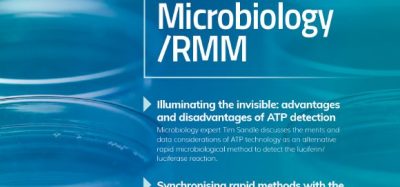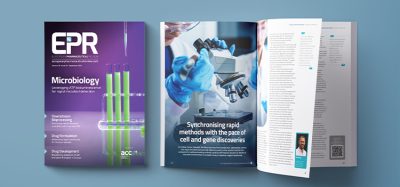New year, old challenges!
Posted: 28 February 2012 |
This is the first of many articles in our continuing series on Rapid Microbiological Methods that will appear in European Pharmaceutical Review during 2012. For the past two years, I have enjoyed sharing with you a broad range of topics associated with the validation and implementation of rapid microbiological methods (RMMs), including:
– A review of the history of conventional micro – biology and the benefits of using RMMs
– Validation strategies
– Perspectives from the regulatory authori – ties, including FDA and EMA
– Overviews of currently available tech – nologies, including those based on the growth of microorganisms, detection of cellular targets, optical spectroscopy, nucleic acid amplification and gene sequencing, viability staining and laser excitation, as well as micro-electro-mechanical systems, or MEMS.
In addition to my articles, numerous companies have published their success stories of RMM selection, validation and implementation, for a variety of applications including, but not limited to, sterility testing, bioburden analyses, water testing, environmental monitoring and the detection of Mycoplasma and other micro – organisms.


This is the first of many articles in our continuing series on Rapid Microbiological Methods that will appear in European Pharmaceutical Review during 2012. For the past two years, I have enjoyed sharing with you a broad range of topics associated with the validation and implementation of rapid microbiological methods (RMMs), including:
- A review of the history of conventional micro – biology and the benefits of using RMMs
- Validation strategies
- Perspectives from the regulatory authori – ties, including FDA and EMA
- Overviews of currently available tech – nologies, including those based on the growth of microorganisms, detection of cellular targets, optical spectroscopy, nucleic acid amplification and gene sequencing, viability staining and laser excitation, as well as micro-electro-mechanical systems, or MEMS
In addition to my articles, numerous companies have published their success stories of RMM selection, validation and implementation, for a variety of applications including, but not limited to, sterility testing, bioburden analyses, water testing, environmental monitoring and the detection of Mycoplasma and other micro – organisms. With all of this available information and practical guidance in our hands, it stands to reason that we should now expect a massive undertaking by the industry to put these novel technologies in their rightful place. At least that’s what this author wants to believe. Unfortunately, the acceptance of rapid methods continues to be hampered by misconceptions, misunder – standings, preconceptions, biases, prejudices, prejudgments, and above all, myths. The harsh reality is that many in our industry would rather promote doubt over acknowledgment that rapid methods may actually lead to a better quality product, manufacturing efficiencies, significant returns on investment and increased process knowledge. And in an era where product quality is at the forefront of patient safety, rapid methods should be considered as analytical tools to monitor and, under the right strategy, control adventitious contamination. Propagating the so-called ‘myths’ associated with RMM imple mentation should once and for all be terminated, and this is the focus for my first article of the New Year.
Myths and rapid methods
A myth can take on many forms including a widely held but false belief or idea, a mis – representation of the truth, a fictitious or imaginary person or thing, or an exaggerated or idealised conception of a person or thing. Many myths associated with rapid methods can fall under each of these categories. For example, widely held but false beliefs or ideas include:
- Rapid methods are not accepted by regulatory authorities
- They do not support QbD or PAT principles or initiatives
- They will never replace pharma copoeial tests
- There is little validation guidance
- RMMs offer no return on investment
Similarly, rapid method myths that foster a misrepresentation of the truth include:
- Data from RMMs will exceed our specifications and action levels, which will translate to an increase in batch rejections
- Changing acceptance levels will not be allowed
- It will take forever to gain regulatory approvals
- There’s just not enough information or guidance out there
Some in the industry do not want to explore the use of a rapid method unless it detects, enumerates and identifies viable micro organisms at the single cell level while doing this all at the same time. This sounds like a fictitious or imag – inary thing to me. Finally, the notion that rapid methods will solve all of your contamination and product quality issues is an exaggerated or idealised conception. Yes, RMMs can provide a better understanding of your contamination control efforts and offer enhanced process and product knowledge (from a microbiological perspective), but RMMs are analytical tools to help us get there, and not the end all.
The impact on industry
Although companies have successfully validated and implemented rapid methods, both in the US and throughout Europe, many firms don’t want to be the first on their block to go down this path. Or, they believe it will cost too much and that the regulatory authorities won’t understand the concepts. Additionally, we’ve been doing just fine all this time, right (i.e., if it ‘ain’t’ broke, why fix it?)? Furthermore, we proclaim to embrace 21st Century manu – facturing technologies to deliver 21st Century quality product, but continue to use 19th Century microbiology methods. If you were external to our industry, would you trust us to make quality pharmaceuticals, given the fact that we continue to address contamination problems which impact our production lines and in some cases, our products? It’s time to move forward and accept the next generation in microbiology testing. But first, we have to debunk these rapid micro method myths.
Myth: RMMs are not accepted by the FDA
Regulatory acceptance is the industry’s greatest fear and bewilderment. The authorities not only understand, but also embrace and encourage the use of RMMs. Whether it be the FDA, EMA, Japanese PMDA or Australian TGA, policy and guidance have been modified or introduced that promote the use of alternative micro – biological methods, and even make it easier to get them approved. For example, the FDA’s Guidance for Industry: Sterile Drug Products Produced by Aseptic Processing – Current Good Manufacturing Practice, recommends the use of rapid genotypic methods for microbial identification because they have been shown to be more accurate and precise than biochemical and phenotypic techniques. The guidance also states that other suitable microbiological tests (e.g., rapid methods) can be considered for environmental monitoring, in-process control and finished product release testing, as long as they have been demonstrated to be equivalent or better than the conventional methods.
In 2008, FDA’s Center for Biologics came out with a draft guidance entitled the Validation of Growth-Based Rapid Microbiological Methods for Sterility Testing of Cellular and Gene Therapy Products. The document provides a roadmap for demonstrating that an alternative, growthbased RMM is equivalent to the conventional sterility test method.
More recently, the US Federal Register proposed to amend the sterility test require – ments for biological products because “Advances in technology in recent years have allowed the development of new sterility test methods that yield accurate and reliable test results in less time and with less operator intervention than the currently prescribed culture-based methods.” Furthermore, this 2011 proposal is supported by internal assessments of rapid methods within FDA’s own test laboratories.
And most recently, the FDA published their new strategic plan for regulatory science, which includes the development of “sensitive, rapid, high-throughput methods to detect, identify, and enumerate microbial contaminants and validate their utility in assessing product sterility.”
Clearly, the FDA accepts the use of rapid methods. And the Agency has encouraged the industry to openly discuss their validation and implementation strategies with FDA micro – biologists, in addition to using filing and notification tools such as comparability protocols and a reduced reported structure for communi – cating when the RMM is being implemented (e.g., Changes Being Effected-0, or CBE-0).
Myth: RMMs are not accepted by European regulators
The European regulators have expressed their acceptance of RMMs for a number of years. At a PDA RMM meeting in 2009, Riccardo Luigetti (EMA) stated that RMMs clearly have the potential to be used to support QbD, and that the introduction of these methods is generally supported by the EU regulatory competent authorities. Additionally, Paul Hargreaves (MHRA) has communicated that his agency has actively encouraged the pharmaceutical industry to implement RMMs in order to improve patent safety.
In 2005, the EMA Quality Working Party provided guidance on the use of alternative methods for the rapid control of microbiological quality of WFI and purified water. Since it is expected that the water will continue to meet Ph. Eur. specifications, if tested, the QWP stated that no change to dossier requirements should be required (depending on the level of detail in the original dossiers concerned) and that no regulatory impact on individual products would be anticipated.
A more recent change to EMA policy includes the introduction of the Post Approval Change Management Protocol (PACMP). This is similar to FDA’s comparability protocol, where the proposed RMM validation test protocol is submitted to EMA for approval (as a Type II Variation), and then the subsequent data is submitted as a Type IA or IB variation. This new protocol approval process takes much of the uncertainty out of the equation with regard to whether a validation strategy and test plan is acceptable, which was a deterrent for many companies in the past (previously, companies would submit their validation data and hope that they would not have to repeat the test or significantly change the test strategy following EMA review). Moreover, under the new PACMP procedure, data submitted as a Type IA variation can allow the RMM to be implemented immediately, which is similar to FDA’s CBE-0 notification process.
Myth: RMMs have no impact on product quality
For many years, our industry has successfully provided pharmaceuticals to the public using batch processing with laboratory testing conducted on collected samples to ensure product quality. However, we are not an industry without contamination events, and some firms have faced significant microbiological control issues, which have resulted in facility closures and even product recalls. So where would RMMs fit in? Quality by Design (QbD) and Process Analytical Technology (PAT) principles teach us that we can use analytical tools to implement ‘real time’ quality control, increase our level of automation and ensure predefined product quality at the end of the manufacturing process by monitoring and controlling the process as it happens. Rapid methods can be used for real-time or close to realtime microbial detection in environmental monitoring, process water, fermentation and a variety of in-process bioburden samples. That’s the monitoring piece in PAT. The control piece occurs when we observe a contamination event, as it is transpires, because RMMs allow us to respond much faster than if we were using conventional methods (actually, we wouldn’t be able to respond in a timely manner when using conventional methods because our results wouldn’t be available for days after the event occurred!). Now we can stop the manufacturing process, investigate the issue in real-time, be in a better position to quickly resolve the issue, segregate the affected product or in-process material (when appropriate), and once we are back in control, continue with production.
Furthermore, the data generated from many RMM technologies are rich with information, and can subsequently be used to enhance our process knowledge. Now we can be proactive in continuously improving our processes and engineer potential con – tamination out of the picture.
Myth: RMMs will never replace finish product testing
It already has. A number of companies have obtained regulatory approval (FDA and EMA) for using rapid methods as an alternative to the compendial sterility test. And other firms have used rapid method technologies for the release of non-sterile pharmaceutical preparations, instead of waiting for the results of a compendial Microbial Limits Test. This is only the beginning.
Myth: there’s not enough validation guidance
There are currently three guidance documents for the validation of rapid methods: PDA Technical Report #33, USP <1223> and Ph. Eur. 5.1.6. For a number of years, firms have utilised these documents to successfully validate, gain regulatory approval and implement their RMMs. I will note that each of these documents is currently under revision, but the overall guidance should not change significantly.
Myth: there’s no return on investment
There has always been the perception that the cost of RMM capital equipment and validation will far outweigh the cost savings. However, no one, not even your production manager, site head or COO, can make that assumption unless you have performed a financial analysis, comparing the overall costs associated with the existing method and the proposed RMM. Truth be told, some companies have realised huge savings when implementing rapid methods. This will be a topic I will cover in great detail later this year.
Myth: we can’t change our acceptance levels
Some RMMs, especially those that do not rely on microbial growth, may provide a higher recovery count as compared with traditional methods. Furthermore, some RMM measure – ments may be completely different from what we have been historically used to (e.g., fluorescent units vs. CFU). For example, Dr. David Hussong (FDA) has stated that rapid methods may rely on a completely different body of information; some may be direct measurements, some indirect. In either event, previous acceptance criteria may not be applicable. Therefore, implementation of newly developed, or more rapid, microbiology methods may also require establishment of new acceptance criteria. Handling acceptance levels is something you can include in your validation and implementation strategy, and if you have any doubt, I encourage you to discuss this topic with the relevant regulatory authorities.
Myth: we need the Holy Grail
I have heard, on more than one occasion, that a company will only consider a RMM if it detects, enumerates and identifies viable micro – organisms at the single cell level and do each of these tasks all at the same time. Wake up people. We are getting close, but the state of the art is not quite there yet. For example, Raman spectroscopy is in a good position to be able to detect, count and ID single cells that are captured on a membrane. But more work needs to be done, and RMM technologies will catch up with our desires. In the meantime, many companies have employed one RMM for enumeration, and a separate RMM for identification or the detection of specific organisms of interest. And there are acceptable strategies for using ‘destructive’ RMMs, or RMMs that do not capture microorganisms, for subsequent testing. Simply put, unless you are Robert Langdon, Indiana Jones or Monty Python, leave the Holy Grail for another day.
Myth: RMMs will solve all of your contamination problems
No, not all of them, but RMMs may be able to help you understand why you are having contamination events, what the root cause is, and how to resolve the issues. Rapid methods can support a comprehensive contamination control program, and when contamination arises, they can be used as investigative tools. I do believe that if RMMs were more widely used within the industry, a number of firms may have had a better opportunity to detect con – tamination issues, remedy the situation and prevent future contamination from occurring, long before those same companies were forced to shut down manufacturing lines, close their facilities, or recall their products because of the presence of microorganisms.
Myth: there’s not enough information about RMMs
I already mentioned the availability of three guidance documents for RMM validation, but there are other sources of information in the public domain. Publications, such as the one you are reading, have provided papers on RMM validation, implementation, technologies and other topics of interest. There are conferences dedicated to rapid methods, as well as online user groups (e.g., ‘Rapid Micro Methods’ on LinkedIn). Another comprehensive resource for all things rapid methods is my own educational website, http://rapidmicromethods.com. Here you will find a holistic overview of validation strategies, regulatory expectations, return on investment guidance, scientific tutorials, current RMM news, a calendar of events, newsletter and my blog. A recent addition is the RMM Product Matrix, where you can compare more than 50 different rapid method technologies, with details including scientific methods, applications, time to result, throughput, sensitivity, organisms detected, identification libraries and product workflow, arranged in three separate comparison tables (microbial identification, qualitative and quantitative methods).
Summary
After reading this article, I hope you agree that most rapid method myths that have been circulating throughout the industry are just not true. Regulatory authorities want RMMs implemented, and their use is directly aligned with the future state of pharmaceutical manufacturing, QbD, PAT and continuous process and product improvement. There is validation guidance and this guidance will become clearer. Also, the cost of imple – mentation can be a good investment. So stop listing to the naysayers, cynics, sceptics and worrywarts, and embrace microbiology for the 21st Century. I have a feeling our friend Louis Pasteur would agree!
About the author
Dr. Michael J. Miller is currently the President of Microbiology Consultants, LLC (http://microbiologyconsultants.com). For more than 23 years, he has held numerous R&D, manufacturing, quality, and consulting and business develop – ment leadership roles at Johnson & Johnson, Eli Lilly and Company, Bausch & Lomb, and Pharmaceutical Systems, Inc. Dr. Miller consults with multinational companies in providing technical, quality and regulatory solutions in support of RMMs, sterile and non-sterile pharmaceutical manufacturing, contamination control, isolator technology, validation and microbiological PAT. He also provides comprehensive training for his clients in the areas of rapid method validation and implementation. Dr. Miller has authored over 100 technical publications and presentations, is the editor of PDA’s Encyclopaedia of Rapid Microbiological Methods, and is the owner of http://rapidmicromethods.com. He currently serves on a number of PDA’s program and publication committees and advisory boards, is co-chairing the revision of PDA Technical Report #33: Evaluation, Validation and Implementation of New Microbiological Testing Methods. Dr. Miller holds a PhD in Microbiology and Biochemistry from Georgia State University (GSU), a BA in Anthropology and Sociology from Hobart College, and is currently an adjunct professor at GSU. He was awarded PDA’s Distinguished Service Award and was named Microbiologist of the Year by the Institute of Validation Technology (IVT).









